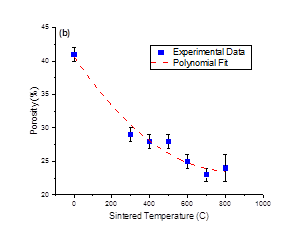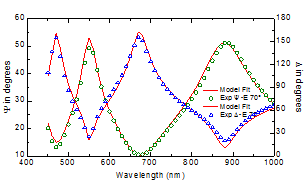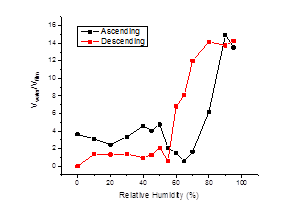Reports: UR1056264-UR10: Fundamental Properties of Porous Structures and the Dynamics of Adsorbent-Pore Interactions
Frank C. Peiris, PhD, Kenyon College
As described in the original proposal, in the past year, we have worked on a variety of important issues regarding porous materials, mainly to further understand their various characteristics, including their architecture, composition, diameter, distribution and anisotropy. The main tool that we have used for this purpose is spectroscopic ellipsometry. Traditional ellipsometry is a nondestructive technique used to obtain information regarding the dielectric function, thickness, interfaces, anisotropy, and composition of various materials by monitoring the changes in the polarization state of the incident and the reflected light. Besides this method, we have also used ellipsometric porosimetry (EP), a novel technique that has been developed recently. This technique is based on the fact that as vapor is infiltrated into pores, the effective dielectric function of the structure will undergo changes which can be monitored through conventional ellipsometry. By analyzing the isotherms, the necessary parameters of the porous structures are determined.
Porous Structures Based on Nanoparticle Ziconia
Zirconia nanoparticles possess interesting properties due in large to their high elastic modulus (~200 GPa), colloidal stability of their dispersions, and high yield of the reaction that produce them (nearly 50%). For our study, a series of porous films were produced using zirconia nanoparticles (~4 nm diameter), which were separated with either trioctylphosphine oxide (TOPO) or oleic acid. Films were produced by spin-coating the nanoparticles on to Si substrates. The as-grown samples were then exposed to O2-plasma, which removed the alkyl tails of the ligands, and subsequently sintered at various temperatures (300° C - 900° C) in order to produce films of different porosities.
The porosities that were obtained from the ellipsometry measurements, for both the TOPO and oleic acid-capped samples are shown in Figure 1. While the porosity values decrease for both types of samples, the porosity seems to decrease faster for the samples that are capped with oleic acid. This study shows that the porosities of zirconia nanoparticles can be controlled by the sintering temperature. Since the changes in the porosities have a direct correlation on their chemical behavior, the sintering temperature is a way to engineer the behavior of these interesting nanoparticle structures.
Figure 1. The porosity values determined by ellipsometry for TOPO-capped (a) and Oleic acid-capped (b) zirconia nanoparticle films. While the porosity reduces as the sintered temperature increases, the fits show that the reduction depends on the capping ligand.
Periodic Mesoporous Films
Periodic mesoporous films (PMFs) manifest remarkable properties including the ability to be synthesized with varying characteristics. For instance, its pore diameter can be changed between 2-50 nm, its porosity can be changed up to 65%, and its pore geometry can be configured to be cylindrical or spherical. Furthermore, various compounds can be used to fabricate the skeleton of PMFs, and in some case, the structure of the compound can be changed from amorphous to crystalline, or to a mixed phase. For this particular study, we synthesized PMFs based on titania. After spin-coating thin films on Si substrates, with varying thicknesses, the films were calcined at various temperatures in order to study their pore-characteristics as a function of temperature.
While traditional ellipsometry was used to determine the porosities and film thicknesses, ellipsometric porosimetry (EP) was used to further investigate other characteristics, such as the pore diameters and their distributions. In Fig. 2, ellipsometry spectra are shown for a representative sample, calcined at 400°C. Using a standard effective medium approximation model, the porosity of this sample was calculated to be 31.5%. The fitting results for this model are shown as red lines, for both psi and delta spectra obtained by ellipsometry. The quality of the fit attests to the validity of the model and the uncertainty of the porosity values calculated from this method is within 3%.
Figure 2. (Left) Ellipsometry spectra psi and delta are shown for a representative sample calcined at 400°C. Using a standard effective medium approximation model, the porosity of this sample was calculated to be 31.5%. (Right) The isotherm obtained for the same sample using ellipsometric porosimetry.
For the same sample, in Fig. 2 (right), we show the isotherm obtained from EP measurements. The sample was mounted in a chamber, where the relative humidity (RH) was changed continuously by infiltrating water vapor. Subsequently, ellipsometry measurements were obtained at each RH-value. Measurements were obtained for both ascending and descending values of RH which is indicated by the black and red curves, respectively. While the isotherms obtained from EP were slightly noisy, preliminary analysis of these results indicate that the pore diameter for the most samples were around 4 nm. Presently, we are in the process of further optimizing the experimental conditions in order to reduce the uncertainties of the measurements. Additionally, we are also modifying the EP apparatus so that it has the ability to infiltrate other solvents, including ethanol and acetone.
Effective Medium Approximation
Our final project was to explore the effective medium approximations (EMAs) that are used to describe porous structure. While traditional EMAs, pioneered by Maxwell-Garnett and Bruggeman, have been successful in tackling a plethora of problems, they are insufficient to handle problems with more complex geometries. Specifically, they cannot handle porous structures with noncircular cross sections as well as structures that manifest anisotropy, both of which are present in some of the porous structures we have studied. The theory, developed to handle this particular problem, takes into consideration how the depolarization effects – due to the shape of the pore – alter the local field created at the pore location. With this modification, the extended-EMA allows one to tackle problems with complex pore geometries as well as to apply the method for systems with optical anisotropy. For our preliminary studies, we have used a volume averaging theory (VAT) to determine the pore characteristics. The VAT model is more appropriate for high-porosity structures as well as systems where the constituents have high indices of refraction. Presently, we are in the process of verifying the porosity values obtained from the VAT theory with Rutherford back-scattering data.















